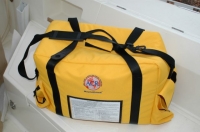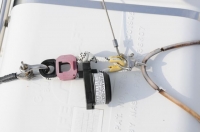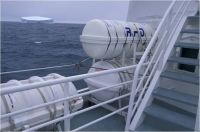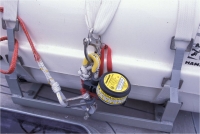Life Raft Details
Part II
Make certain you understand how life raft security and deployment mechanisms are designed to work, don’t assume they’ve been properly rigged. In the manner in which this raft’s release mechanism has been installed, if it were to deploy manually the raft would not inflate nor would it remain attaced to the vessel.
In part one of this two part series we discussed life raft and surviuval history, EPIRBs, raft designations and features. In this second and final segment of the life raft discussion we’ll discuss raft contents, ditch bags, deployment and service.
If there is one feature of a life raft you already own, or intend to purchase, that you should inspect, touch and hold, it is the contents of the survival pack. In inspecting various kits at a local life raft repacking facility, I was amazed at the range of quality in the individual components, particularly for non-SOLAS/USCG approved kits. For example, some paddles are substantial aluminum or wood affairs that would be adequate for every day use, while others are over-sized mittens that you actually wear on you hands. Perhaps the most troubling disparity is in repair kits. If you are in a life raft long enough, chances are very good that it will develop a leak. Imagine attempting to repair one of these leaks, below the water line, with a patch and liquid glue? Invariably, these kits require that the area be clean and dry before attempting repair. If nothing less, that kind of equipment would give a life raft occupant the will to survive, just so he or she could return to civilization to give the raft manufacturer a piece if his or her mind.
Conversely, high quality raft manufacturers provide repair kits that require neither glue nor dry surfaces but instead utilize purpose-made clamps and plugs. Once again, make the effort to inspect these items, whether you are intending to purchase or already own the raft. In the latter case, it’s never too late to replace or supplement these items.
Some life raft manufacturers take their raft’s contents very seriously, including a 406 EPIRB and reverse osmosis water maker. Sound reasoning dictates that the less you have to remember to bring with you when abandoning ship, the less you can forget. If the impetus for abandoning ship necessitates a hasty departure, fire or rapid flooding, then there is a good chance that critical items, such as a portable desalinator and EPIRB, may be left behind. It should come as no surprise that rafts that are as well equipped as these are usually more expensive and often (but not always) heavier than competitor’s rafts.
The contents of the survival pack should ensure, at a minimum, your survival for a reasonable period. Once again, if you are not under the super SAR umbrella, this period may be several weeks rather than several days. In either case, cautious cruisers will not count on SAR assets coming their way soon and will instead opt for maximum self sufficiency by ensuring the contents of their survival packs and ditch bags are more than simply adequate.
A ditch bag can augment the contents of a raft, which by necessity must be of limited volume. And, once items are packed in the raft, they are inaccessible unless the raft is deployed.
Deployment
No discussion on life rafts would be complete without some discussion as to their proper security, installation and deployment. As previously mentioned, there are both pros and cons to canisters and valises. If you opt for the former, keep the following guidelines in mind. The life raft chapter of the ISAF Offshore Special Regulations, available from US Sailing (www.ussailing.org) recommends that, “Each raft shall be capable of being got to the lifelines or into the water within 15 seconds”. How or where ever you opt to store your raft, on deck or below, ensure that it meets this minimum recommendation. Clearly, most on-deck canister installations will meet this standard. Valises that are stored below must be easily accessible at all times throughout your passage. If gear, food or tools slowly bury them, you may not be able to get to them within the prescribed time.
For canister type, on deck installations security is critically important. Ideally, the canister cradle should be mounted aft, where it is easily accessible from the cockpit as opposed to on the foredeck. This allows the crew to access the raft without going forward, which might be undesirable in rough weather. Additionally, the raft is better protected from boarding seas in this location and, it is less likely to become entangled in rigging in the event the vessel sinks before deployment.
Commercial vessels and those operating in challenging conditions go to great lengths to ensure the security of rafts before they are deployed.
The one feature of canister and cradle installation that is not optional or open to discretion are its fastenings. The cradle must be either substantially through bolted, utilizing proper backing plates or welded, in the case of aluminum or steel vessels, to the deck. Any other type of fastening creates the potential for your raft being swept away by boarding seas, perhaps when you need it most.
On deck canister rafts must be well secured, this means through bolts or machine screw fasteners threaded into metal that’s been laminated into the deck for this purpose. Security is paramount, particularly for rafts that are in locations where they may be swept by boarding seas.
Canister type rafts may utilize a device commonly known as a hydrostatic release mechanism. These will, when submerged to a predetermined depth (approximately 4 meters), release the raft. Once the canister is released from its cradle, it will float with enough buoyancy to pull the painter out of the canister. As previously mentioned, once the painter has been fully deployed, it will trigger the C02 canister, inflating the raft.
Some hydrostatic release mechanisms also incorporate a “weak link” device, which is designed to break when a specified force is applied (for the most common hydrostatic release, the HammarH20, this is either 500 lbs, which is signified by a red weak link, or 270 lbs, which is signified by a green weak link). This weak link will prevent the raft from being pulled under or damaged when the vessel sinks.
The familiar hydrostatic release mechanism. Like flares, EPIRB batteries and life rafts themselves, these require inspection and periodic replacement. Also, counterfeit units have been encountered, so make sure yours is genuine by contacting the manufacturer for verifying features or serial numbers.
Like all automatic devices, hydrostatic releases are not absolutely reliable. They may fail in one of two ways, either not releasing when they should, or releasing when they shouldn’t. I have personally experienced the latter scenario, where a canister type raft was installed on the cabin top of a 30-foot trawler, approximately 10 feet above the water line. During moderately rough weather, where seas were approximately 10 to 15 feet, the vessel was struck by a wave that caused the hydrostatic release to deploy the raft. The raft fell overboard, the painter paid out, triggering the inflation trigger. It worked perfectly, except the raft wasn’t needed, then, or later, thankfully. An hour later, the raft, after being bailed out and partially deflated, was secured in the cockpit. The raft was inadvertently towed for a short distance, imparting enough drag, thanks to ballast bags and drogue, to distort the through bolted aluminum cradle. Notably, the weak link did not part.
The hydrostatic release equipped raft aboard this vessel deployed when she was swept by a moderately (when compared to the size of the vessel) sized wave. The empty raft cradle can be seen to the right of the crew member standing aft.
An idiosyncrasy of most hydrostatic releases is that if the raft is manually released the weak link is disabled. Thus, hydrostatically equipped rafts that are deployed by the crew, rather than by the sinking vessel, will not benefit from the weak link’s self-separation feature. The painter must, in these cases, be cut.
Most hydrostatic release mechanisms are not serviceable; they simply expire. The aforementioned Hammar brand may be used within its manufacturer’s guidelines for two years, after which time it should be replaced. Check the expiration decal to determine when the unit will require replacement.
It may be a worn out expression, but I would be remiss if I did not repeat it when discussing abandoning ship. Don’t get off the mother ship until you have to step up into the life raft or the flames are licking at your heels. Your chances of survival and rescue are frequently much better aboard the larger vessel. Staying aboard will also afford you the time required to collect essential items, such as food and water (water jugs should be stored with an air space of 25 or 30 percent to ensure they will float high) before stepping off the deck for the last time.
Service
Getting your life raft serviced regularly is like going to the doctor for a check up when you feel fine. It’s easy to talk yourself out of the trip, but you shouldn’t. Most raft manufacturers specify recommended service intervals. For inspected commercial vessels, this is usually an annual event. For non-inspected vessels, we cruisers, there is no mandatory inspection period. All raft manufacturers, however, strongly recommend a voluntary inspection interval of anywhere between one and three years, depending on the raft and how it is packed.
Life raft service facility. Choose yours wisely.
Vacuum packing has enabled some manufacturers to stretch the first interval to three years, with succeeding intervals at two years and then one year, but this does vary with manufacturer, so check with yours before creating an inspection schedule.
Providing your raft with regular service is of little value if the service facility you are taking it to is not qualified to do the job. The life raft service station you choose must have, among its staff, personnel who are trained and experienced in servicing your particular make and model of raft and their training must be current. Most service certificates are only valid for three years and most service facilities proudly display these documents. Furthermore, if your raft is USCG approved, the facility must have USCG approval for servicing that make and model of raft.
The most reliable approach for determining if your life raft service facility possesses the necessary qualifications to work with your raft is to call or e mail the manufacturer of your raft. Raft manufacturers will usually provide this information without hesitation. Additionally, you may go to the website of the United States Marine Safety Association (www.usmsa.org). This is an organization whose members include most life raft service facilities. Their website contains a database of most life raft manufacturers and their qualified (and USMSA member) service facilities. Membership in this organization is not a guarantor of excellence or competence; however, it is an indication that the participating service facility is proactive in the industry.
Once at the facility, your raft will be inflated with compressed air (USCG/SOLAS rafts must undergo an “operational inflation”, using the raft’s own CO2 canister, every 10 years) in order to undergo the prescribed battery of tests for leaks. Additionally, the raft will be checked for deterioration of the fabric and metal components. Rafts that have gotten wet in their valises and canisters frequently suffer some damage, sometimes irreparable. Perishable items, such as flares (3 years), batteries (1 year), food (5 years) and water (5 years), among other items, should be replaced. CO2 bottles must be hydrostatically tested every five years.
Most life raft service facilities will allow you to make an appointment to see your raft while it is inflated. This will afford you the opportunity to see and analyze the contents of the survival pack (and add a few personal items such as eye glasses and prescription med’s), as well as assessing the size and features of your raft. Keep in mind; however, that life raft service facilities are for profit businesses and as such their time and the time of their employees is valuable. The management would no doubt, not welcome an all day visit. Twenty minutes or half an hour is all you should need to inspect and familiarize your self with the above-mentioned items.
Dr. David Lewis, the recently deceased cruiser, explorer and adventurer made clear in his book “Icebird”, a chronicle of his solo passage to Antarctica in a 32-foot sloop, his sentiments concerning distress. “The ocean cruiser is on his own. He must think in terms of self-help – indeed, he should have been doing so all along.” Certainly, once you are in a raft your fate is, if you are fortunate, in the hands of the folks who listen for EPIRB signals. However, the notion of self-reliance is valid and can be carried with you into the life raft. The best survival tool you possess is your intellect and experience. Learn about your raft, know it, its equipment and how it all works, or doesn’t work, before you really need it.
©2009 Steve D’Antonio Marine Consulting, Inc.










